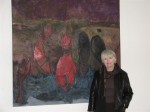Midwest Murals at Grohmann Museum
Few persons view art with a totally unbiased eye. Though critics may claim to do so, it’s
almost impossible. I knew prior to viewing the works of American artists Joe Jones (1909-1963) and J.B.Turnbull (1909-1976) that I’d be dazzled by Midwest Murals, on loan from the Haggerty Museum of Art. Floor two of the Grohmann Museum, 1000 N. Broadway, now through Dec. 6, is where to head.
My bias is a yearning for the Midwest-land-of-farms where my ancestors settled in the mid-1880s. It’s the widescreen Technicolor land of valleys and blue skies, but my memory lies. Farming has always been hard scrabble, a wrestling match with the elements.

Threshing the Wheat by Joe Jones (American, 1909-1963) canvas on masonite, 38 ¼ x 145 ¾ in. Courtesy, Haggerty Museum of Art, Marquette University.
Jones and Turnbull took their marching orders from the proprietor of a St. Louis liquor store, who, with the demise of Prohibition, had cash aplenty to hire painters to sanitize late ’30s Midwestern work scenes. The long, narrow format signaled they were customized for the long, narrow spaces above his shelves and shelves of booze, indeed, Ready for Action checks in at 228 inches of oil on canvas.
The elongated format suggests an America seen through a stereoscope where sky, land,
man and mule meld in harmony. Though the scenes depict multiple mules and multiple workers under endless skies (doesn’t it ever rain in Missouri?), there lurks an element of despair. It’s hard to shake the knowing that my rural hometown is now mostly boarded and bare. So much for “amber waves of grain.”
The paintings lack evidence of sweat or stress, nor are there black laborers in sight. This isn’t to say that the artists were blind to the problems of workers (or artists’ causes), indeed, both men were radical social activists who later moved
east to forge their “workers’ rights” agenda. The fee for the murals may have been their ticket out of the St. Louis area. In any event, they pursued their unsanitized, radical social activism on the East Coast where folks were less uptight.
For more on the back story, Curtis L. Carter, Ph.D., professor of aesthetics and philosophy at Marquette University, will offer his expert take on the murals. He’s the founding director of the Haggerty Museum and a lively speaker. Tune in Friday, Oct. 16, at 7 p.m. Visit the MSOE website for more information.
Midwest Murals by Joe Jones and J.B. Turnbull
Through Dec. 6
Grohmann Museum, MSOE
1000 N. Broadway, Milwaukee
Monday –Friday, 9 a.m. to 5 p.m.
Saturday, Noon to 6 p.m.
Sunday, 1 p.m. to 4 p.m.
Art
-
Winning Artists Works on Display
 May 30th, 2024 by Annie Raab
May 30th, 2024 by Annie Raab
-
5 Huge Rainbow Arcs Coming To Downtown
 Apr 29th, 2024 by Jeramey Jannene
Apr 29th, 2024 by Jeramey Jannene
-
Exhibit Tells Story of Vietnam War Resistors in the Military
 Mar 29th, 2024 by Bill Christofferson
Mar 29th, 2024 by Bill Christofferson






















Thanks for the engaging review, Judith Ann. — Tom
Of course these aren’t realistic depictions of agriculture in the early 20th century; case in point: the spankin’ white shirts and coordinating farmwear. But the original viewers of these works knew that – keep in mind that nearly a fifth of the population was directly involved in farmwork at that time.
However, the progressively-minded artists of that time weren’t after deception. What they were after was an ennobled depiction of everyday labor. Their subjects weren’t hardscrabble farmers – they were midwestern gods of agriculture, whose work was the true core of the American empire.
The fact that these works were commissioned by wealthy business owners has a delightfully subversive wink to it.